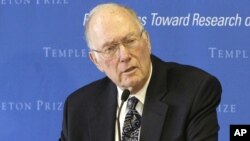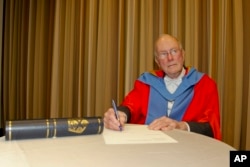It is difficult to overstate the impact that laser beam inventor Charles Townes’ work had on the world.
Supermarket scanners, DVD players, laser printers, medical devices used to perform eye surgery, the precise measurement of time, the long-distance surveying of stars and planets — all of these technologies stemmed from the development of the laser by Townes, who died this week at age 99.
During a visit to Washington, D.C., in the early 1950s, as he sat on a park bench across from the White House, Townes, who headed the physics department at Columbia University in New York, solved a daunting problem: how to manipulate microwaves into a focused beam.
That idea initially became a device that emitted short-wavelength, high-frequency microwaves.
The jump from microwaves to a direct beam of light came soon after, and the first operational laser — short for light amplification by stimulated emission of radiation — was built in 1960.
In 1964, Townes won the Nobel Prize for his invention.
The laser has since revolutionized the fields of defense, telecommunications, medicine and consumer electronics.
William Happer, a professor emeritus of physics at Princeton University in New Jersey, knew Townes.
“He really got going right after World War II, when all of the surplus radar equipment was available," Happer said. "So you could get set up at modest cost to do very significant experiments in the late 1940s, early 1950s, and Charlie was smart enough to take advantage of that. And so he and his students did just spectacular work on outlining ... microwave properties of various molecules.”
Born in Greenville, South Carolina, in 1915, Townes was a brilliant student who graduated from high school at age 15 and earned two bachelor's degrees by the time he was 19.
Throughout his career, Townes moved seamlessly among the laboratory, government and academia to pursue his interest in basic science.
According to Richard Osgood, a professor emeritus of electrical engineering and applied physics and mathematics at Columbia, no one — least of all Townes — could have imagined how his technology would eventually explode.
“It’s very, very hard to predict how things go technologically," Osgood said. "They go all over the place in ways you haven't every dreamed of.”
In the end, what impressed people who knew Townes was his lack of pretension and his interest in other aspects of life, including the preservation of chestnut trees and his religious faith, which he believed was compatible with scientific inquiry.










